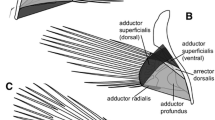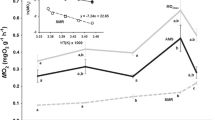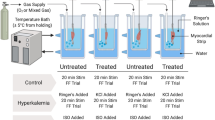Abstract
Biochemical indices of aerobic and anaerobic metabolic capacity were measured in white myotomal muscle of eight marine elasmobranch fish species representing a broad range of locomotor performance, and in red myotomal muscle and heart of three of those species. The objectives were to determine if metabolic capacities vary with typical fish activity level, to compare the endothermic mako shark with ectothermic pelagic sharks, and to compare elasmobranchs with teleosts in order to test the hypothesis that elasmobranchs have lower aerobic capacities, metabolic rates, and swimming speeds. In white myotomal muscle, activities of the enzymes citrate synthase (an index of aerobic capacity), pyruvate kinase, and lactate dehydrogenase (LDH, an index of anaerobic capacity) covaried with typical activity level, and the ability to tolerate intracellular acidification (nonbicarbonate buffering capacity) corresponded with LDH activity. Enzyme activities in red muscle and heart did not show a consistent pattern with respect to fish activity. In comparison with ectothermic sharks, the mako shark had greater aerobic and anaerobic capacities in white muscle, but no significant differences were found in red muscle or heart. This pattern has also been found in teleosts. Thus, endothermic fishes elevate the temperature of red muscle, a tissue specialized for high aerobic performance, whereas white muscle biochemical characteristics are adjusted to support high rates of contraction both aerobically and anaerobically. Muscle enzymic activities of elasmobranchs and teleosts with comparable locomotor habits are similar, thus refuting the hypothesis that elasmobranchs are sluggish, with lower metabolic capacities than teleosts.
Similar content being viewed by others
Literature cited
Abe, H., Dobson, G. P., Hoeger, U., Parkhouse, W. S. (1985). Role of histidine-related compounds to intracellular buffering in fish skeletal muscle. Am. J. Physiol. 249: R449-R454
Alp, P. R., Newsholme, E. A., Zammit, V. A. (1976). Activities of citrate synthase and NAD+-linked and NADP+-linked isocitrate dehydrogenase in muscle from vertebrates and invertebrates. Biochem. J. 154: 689–700
Ballantyne, J. S., Chamberlin, M. E., Singer, T. D. (1992). Oxidative metabolism in thermogenic tissues of the swordfish and mako shark. J. exp. Zool. 261: 110–114
Beamish, F. W. H. (1978). Swimming capacity. In: Hoar, W. S., Randall, D. J. (eds.) Fish physiology. Vol. VII. Academic Press, New York, p. 101–187
Block, B. A. (1991). Endothermy in fish: thermogenesis, ecology, and evolution. In: Hochachka, P. W., Mommsen, T. P. (eds.) Biochemistry and molecular biology of fishes. Vol. 1. Elsevier, New York, p. 269–311
Bone, Q. (1978). Locomotor muscle. In: Hoar, W. S., Randall, D. J. (eds.) Fish physiology. Vol VII. Academic Press, New York, p. 361–424
Bone, Q. (1988). Muscles and locomotion. In: Shuttleworth, T. J. (ed.) Physiology of elasmobranch fishes. Springer-Verlag, New York, p. 99–141
Bone, Q., Kiceniuk, J., Jones, D. R. (1978). On the role of the different fiber types in fish myotomes at intermediate swimming speeds. Fish. Bull. U.S. 34: 294–301
Brett, J. R., Blackburn, J. M. (1978). Metabolic rate and energy expenditure of the spiny dogfish, Squalus acanthias. J. Fish. Res. Bd Can. 35: 816–821
Bushnell, P. G., Lutz, P. L., Gruber, S. H. (1989). The metabolic rate of an active, tropical elasmobranch, the lemon shark (Negaprion brevirostris). Expl Biol. 48: 279–283
Carey, F. G., Casey, J. G., Pratt, H. L., Urquhart, D., McCosker, J. E. (1985). Temperature, heat production, and heat exchange in lamnid sharks. Mem. sth. Calif. Acad. Sci. 9: 92–108
Carey, F. G., Scharold, J. V. (1990). Movements of blue sharks (Prionace glauca) in depth and course. Mar. Biol. 106: 329–342
Carey, F. G., Teal, J. M. (1969). Mako and porbeagle: warm-bodied sharks. Comp. Biochem. Physiol. 28: 199–204
Carey, F. G., Teal, J. M., Kanwisher, J. W., Lawson, K. D., Beckett, J. S. (1971). Warm-bodied fishes. Am. Zool. 11: 135–143
Castellini, M. A., Somero, G. N. (1981). Buffering capacity of vertebrate muscle: correlations with potentials for anaerobic function. J. comp. Physiol. 143: 191–198
Childress, J. J., Somero, G. N. (1979). Depth-related enzymic activities in muscle, brain and heart of deep-living pelagic marine teleosts. Mar. Biol. 52: 273–283
Cliff, G., Thurman, G. D. (1984). Pathological and physiological effects of stress during capture and transport in the juvenile dusky shark, Carcharhinus obscurus. Comp. Biochem. Physiol. 78A: 167–173
Crabtree, B., Newsholme, E. A. (1972). The activities of lipases and carnitine palmitoyltransferase in muscle from vertebrates and invertebrates. Biochem. J. 130: 697–705
Dickson, K. A. (1988). Why are some fishes endothermic? Interspecific comparisons of aerobic and anaerobic metabolic capacities in endothermic and ectothermic scombrids. Ph. D. dissertation. University of California at San Diego
Dickson, K. A. (1993). Unique adaptations of the metabolic biochemistry of tunas and billfishes for life in the pelagic environment. Devs envirl Biol. Fish. (in press)
Dickson, K. A., Dall, A. V., Eisman, J. M., McDonnell, E. T., Hendrzak, A. M. (1988). Biochemical indices of aerobic and anaerobic capacity in red and white myotomal muscle of active, pelagic sharks: comparisons between endothermic and ectothermic species. J. Pa Acad. Sci. 62: 147–151
Dickson, K. A., Somero, G. N. (1987). Partial characterization of the buffering components of the red and white myotomal muscle of marine teleosts, with special emphasis on scombrid fishes. Physiol. Zoöl. 60: 699–706
Dobson, G. P., Wood, S. C., Daxboeck, C., Perry, S. F. (1986). Intracellular buffering and oxygen transport in the Pacific blue marlin (Makaira nigricans): adaptations to high-speed swimming. Physiol. Zoöl. 59: 150–156
Evans, D. H. (1982). Mechanisms of acid extrusion by two marine fishes: the teleost, Opsanus beta, and the elasmobranch, Squalus acanthias. J. exp. Biol. 97: 289–299
Ewart, H. S., Driedzic, W. R. (1987). Enzymes of energy metabolism in salmonid hearts: spongy versus cortical myocardia. Can. J. Zool. 65: 623–627
Farrell, A. P. (1991). From hagfish to tuna: a perspective on cardiac function in fish. Physiol. Zoöl. 64: 1137–1164
Graham, J. B. (1983). Heat transfer. In: Webb, P. W., Weihs, D. (eds.) Fish biomechanics. Praeger Publishers, New York, p. 248–279
Graham, J. B., Dewar, H., Lai, N. C., Lowell, W. R., Arce, S. M. (1990). Aspects of shark swimming performance determined using a large water tunnel. J. exp. Biol. 151: 175–192
Graham, J. B., Koehrn, F. J., Dickson, K. A. (1983). Distribution and relative proportions of red muscle in scombrid fishes: consequences of body size and relationships to endothermy. Can. J. Zool. 61: 2087–2096
Greer Walker, M., Pull, G. A. (1975). A survey of red and white muscle in marine fish. J. Fish Biol. 7: 295–300
Gruber, S. J. (1992). The effects of endurance training on the leopard shark, Triakis semifasciata. M.A. thesis. California State University at Fullerton
Gruber, S. J., Lockridge, K., Dickson, K. A. (1990). Comparisons of muscle aerobic and anaerobic capacity in endothermic and ectothermic shark species. Proceedings of the 70th Annual Meeting of the American Society of Ichthyologists and Herpetologists, June 14–20, 1990. American Society of Ichthyologists and Herpetologists. Charleston, S. Carolina, p. 95
Guppy, M., Hulbert, W. C., Hochachka, P. W. (1979). Metabolic sources of heat and power in tuna muscles. II. Enzyme and metabolite profiles. J. exp. Biol. 82: 303–320
Heisler, N. (1988). Acid-base regulation. In: Shuttleworth, T. J. (ed.) Physiology of elasmobranch fishes. Springer-Verlag, New York, p. 215–252
Holeton, G. F., Heisler, N. (1983). Contribution of net ion transfer mechanisms to acid-base regulation after exhausting activity in the larger spotted dogfish (Scyliorhinus stellaris). J. exp. Biol. 103: 31–46
Johnston, I. A. (1981). Structure and function of fish muscles. Symp. zool. Soc. Lond. 48: 71–113
Johnston, I. A., Brill, R. (1984). Thermal dependence of contractile properties of single skinned muscle fibres from Antarctic and various warm water marine fishes including skipjack tuna (Katsuwonus pelamis) and kawakawa (Euthynnus affinis). J. comp. Physiol. (Sect. B) 155: 63–70
Johnston, I. A., Davison, W., Goldspink, G. (1977). Energy metabolism of carp swimming muscles. J. comp. Physiol. 114: 203–216
Johnston, I. A., Moon, T. W. (1980a). Endurance exercise training in the fast and slow muscles of a teleost fish (Pollachius virens). J. comp. Physiol. 135: 147–156
Johnston, I. A., Moon, T. W. (1980b). Exercise training in skeletal muscle of brook trout (Salvelinus fontinalis). J. exp. Biol. 87: 177–194
Johnston, I. A., Moon, T. W. (1981). Fine structure and metabolism of multiply innervated fast muscle fibres in teleost fish. Cell Tissue Res. 219: 93–109
Jørgensen, J. B., Mustafa, T. (1980). The effect of hypoxia on carbohydrate metabolism in flounder (Platichthys flesus L.). II. High energy phosphate compounds and the role of glycolytic and gluconeogenetic enzymes. Comp. Biochem. Physiol. 67B: 249–256
Lindsey, C. C. (1978). Form, function, and locomotory habits in fish. In: Hoar, W. S., Randall, D. J. (eds.) Fish Physiology. Vol. VII. Academic Press, New York, p. 1–100
Lukton, A., Olcott, H. S. (1958). Content of free imidazole compounds in muscle tissue of aquatic animals. Fd Res. 23: 611–618
Magnuson, J. J. (1978). Locomotion by scombrid fishes. In: Hoar, W. S., Randall, D. J. (eds.) Fish physiology. Vol. VII. Academic Press, New York, p. 239–313
McLaughlin, R. L., Kramer, D. L. (1991). The association between amount of red muscle and mobility in fishes: a statistical evaluation. Envir. Biol. Fish. 30: 369–378
Milligan, C. L., Wood, C. M. (1986). Intracellular and extracellular acid-base status and H+ exchange with the environment after exhaustive exercise in the rainbow trout. J. exp. Biol. 123: 93–121
Moon, T. W., Mommsen, T. P. (1987). Enzymes of intermediary metabolism in tissues of the little skate, Raja erinacea. J. exp. Zool. 244: 9–15
Moyes, C. D., Buck, L. T., Hochachka, P. W. (1990). Mitochondrial and peroxisomal fatty acid oxidation in elasmobranchs. Am. J. Physiol. 258: R756-R762
Moyes, C. D., Mathieu-Costello, O. A., Brill, R. W., Hochachka, P. W. (1992). Mitochondrial metabolism of cardiac and skeletal suscles from a fast (Katsuwonus pelamis) and a slow (Cyprinus carpio) fish. Can. J. Zool. 70: 1246–1253
Okuma, E., Abe, H. (1992). Major buffering constituents in animal muscle. Comp. Biochem. Physiol. 102A: 37–41
Parsons, G. R. (1990). Metabolism and swimming efficiency of the bonnethead shark Sphyrna tiburo. Mar. Biol. 104: 363–367
Rome, L. C., Swank, D. (1992). The influence of temperature on power output of scup red muscle during cyclical length changes. J. exp. Biol. 171: 261–281
Santer, R. M. (1985). Morphology and innervation of the fish heart. Adv. Anat. Embryol. Cell Biol. 89: 1–102
Scharold, J., Lai, N. C., Lowell, W. R., Graham, J. B. (1989). Metabolic rate, heart rate, and tailbeat frequency during sustained swimming in the leopard shark Triakis semifasciata. Expl Biol. 48: 223–230
Sciarrotta, T. C., Nelson, D. R. (1977). Diel behavior of the blue shark, Prionace glauca, near Santa Catalina Island, California. Fish. Bull. U.S. 75: 519–528
Sidell, B. D., Driedzic, W. R., Stowe, D. B., Johnston, I. A. (1987). Biochemical correlates of power development and metabolic fuel preferenda in fish hearts. Physiol. Zoöl. 60: 221–232
Siebenaller, J. F., Somero, G. N. (1982). The maintenance of different enzyme activity levels in congeneric fishes living at different depths. Physiol. Zoöl. 55: 171–179
Siebenaller, J. F., Somero, G. N., Haedrich, R. L. (1982). Biochemical characteristics of macrourid fishes differing in their depth of distribution. Biol. Bull. mar. biol. Lab., Woods Hole 163: 240–249
Slyke, van, D. D. (1922). On the measurement of buffer values and on the relationship of buffer value to the dissociation constant of the buffer and the concentration and reaction of the buffer solution. J. biol. Chem. 52: 525–570
Somero, G. N., Childress, J. J. (1980). A violation of the metabolismsize scaling paradigm: activities of glycolytic enzymes in muscle increase in larger-size fishes. Physiol. Zoöl. 53: 322–337
Somero, G. N., Childress, J. J. (1990). Scaling of ATP-supplying enzymes, myofibrillar proteins and buffering capacity in fish muscle: relationship to locomotory habit. J. exp. Biol. 149: 319–333
Suarez, R. K., Mallet, M. D., Daxboeck, C., Hochachka, P. W. (1986). Enzymes of energy metabolism and gluconeogenesis in the Pacific blue marlin Makaira nigricans. Can. J. Zool. 64: 694–697
Sullivan, K. M., Somero, G. N. (1980). Enzyme activities of fish skeletal muscle and brain as influenced by depth of occurrence and habits of feeding and locomotion. Mar. Biol. 60: 91–99
Swift, D. J. (1983). Blood component value changes in the Atlantic mackerel (Scomber scombrus L.) subjected to capture, handling, and confinement. Comp. Biochem. Physiol. 76A: 795–802
Torres, J. J., Somero, G. N. (1988). Metabolism, enzymic activities and cold adaptation in Antarctic mesopelagic fishes. Mar. Biol. 98: 169–180
Tota, B. (1983). Vascular and metabolic zonation in the ventricular myocardium of mammals and fishes. Comp. Biochem. Physiol. 76A: 423–437
Tullis, A., Block, B. A., Sidell, B. D. (1991). Activities of key metabolic enzymes in the heater organs of scombroid fishes. J. exp. Biol. 161: 383–403
Wells, R. M. G., Davie, P. S. (1985), Oxygen binding by the blood and hematological effects of capture stress in two big gamefish: mako shark and striped marlin. Comp. Biochem. Physiol. 81A: 643–646
Wood, C. M. (1991). Acid-base and ion balance, metabolism, and their interactions, after exhaustive exercise in fish. J. exp. Biol. 160: 285–308
Yancey, P. H., Clark, M. E., Hand, S. C., Bowlus, D., Somero, G. N. (1982). Living with water stress: evolution of osmolyte systems. Science, N.Y. 217: 1214–1222
Yancey, P. H., Somero, G. N. (1980). Methylamine osmoregulatory solutes of elasmobranch fishes counteract urea inhibition of enzymes. J. exp. Zool. 212: 205–213
Author information
Authors and Affiliations
Additional information
Communicated by M. G. Hadfield, Honolulu
Rights and permissions
About this article
Cite this article
Dickson, K.A., Gregorio, M.O., Gruber, S.J. et al. Biochemical indices of aerobic and anaerobic capacity in muscle tissues of California elasmobranch fishes differing in typical activity level. Marine Biology 117, 185–193 (1993). https://doi.org/10.1007/BF00345662
Received:
Accepted:
Issue Date:
DOI: https://doi.org/10.1007/BF00345662




